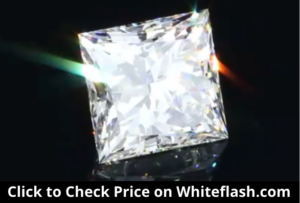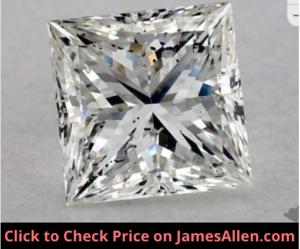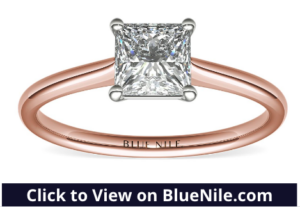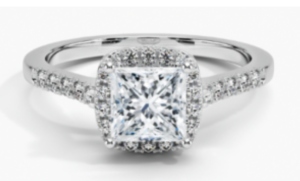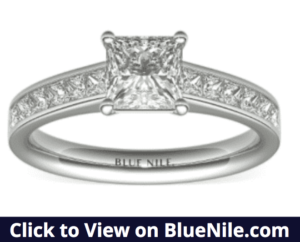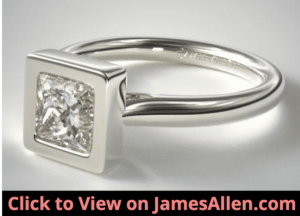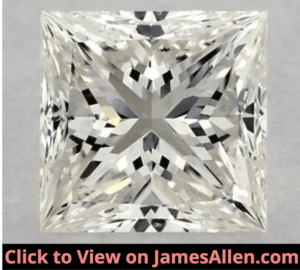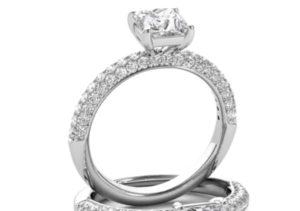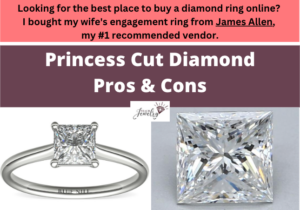
Princess cuts are the second most popular diamond for engagement rings, known for their squarish or rectangular shape and four sharp corners.
A brilliant cut with 57 or 58 facets, it’s often called a “square modified brilliant.” If you’re considering a princess cut, you should understand how the it performs in terms of appearance, light performance, and style.
Let’s examine nine pros and cons of princess cut diamonds so you’ll know if it’s right for you, including how princess cuts score on:
- Affordability
- Brilliance and fire
- Clarity
- Styles of settings
- Durability
- Color
- And more
Here are the details.
Pros of Princess Cuts
More Affordable Than Round Cuts
Affordability is top of mind for many buyers. Princess cuts beat round diamonds in this category for two reasons.
The first is more of the rough diamond is used in the final product, so less is wasted compared to a round cut.
Diamond cutters have to charge a premium for round cuts because so much of the original diamond cannot be used.
The second reason princess cuts are less expensive is there is lower demand for them compared to round cuts.
Decreased demand results in a lower price.
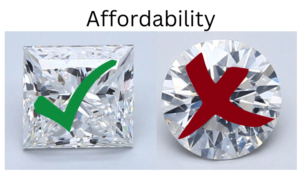
To provide real examples, I compiled the average price for dozens of princess cut diamonds from James Allen, the online diamond vendor where I bought my wife’s engagement ring, and compared them to round diamonds of the same quality.
The princess cuts have the following grades from the Gemological Institute of America (GIA):
- Carat weight: 1.00
- Clarity: SI1
- Color: G
The round cuts have the following qualities:
- Carat weight: 1.00
- Clarity SI1
- Color: G
- Cut: Very good
The average price for a princess cut with those grades is $3,630, with a range of $3,290-$4,060.
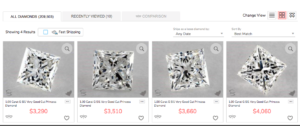
For round cuts with those grades, the average price is $5,209. The range is $4,220-$5,380.
That’s a 44 percent premium for a round cut versus a princess. The highest quality princess cut in that category is a comparable price to the lowest quality round cut.
If you’re looking for the more affordable option between princess and round cuts, or want to put your budget toward the setting or other qualities in the diamond, choose a princess cut.
That being said, princess cuts often cost more than step-cuts emerald, Asscher, or baguette cuts.
They exhibit more brilliance and have a higher demand.
Exceptional Brilliance and Fire
Brilliance refers to the amount of white light returned from a diamond. A diamond’s fire is when white light disperses into a rainbow of colors when it strikes its facets.
Another pro of princess cuts is they have a high amount of brilliance and fire compared to some other cuts. It’s most comparable to round cuts.
Check out the princess cut engagement ring below.
Rotate the image on the vendor’s website, and notice the amount of white light radiating from the diamond, especially toward its center.
Brilliance is one of the most coveted qualities in a diamond because of its visual appeal.
Princess cuts were designed as a square alternative to the round cut that doesn’t sacrifice too much brilliance.
It has a similar number of facets, and the facets themselves are the ideal triangle or kite shape that best allows light to bounce around inside the diamond.
This is in contrast to the elongated facets of a step-cut diamond.
These traits are also what result in enhanced fire. You can see in this image of a princess cut that its facets create colored light as well.
The combined brilliance and fire result in scintillation, which improves its appeal as its twirled.
Hides Inclusions
Inclusions are blemishes inside a diamond that develop because of intense heat and pressure during its formation. None come out truly flawless.
Instead, a flawless grade is reserved for those without inclusions visible at 10x magnification.
Most buyers are concerned with finding a diamond without inclusion visible to the naked eye. This is known as an eye-clean diamond.
As a counter example, here’s a princess cut with significant inclusions.
The GIA reports notes the presence of crystals, feathers, cavities, and naturals.
Still, some cuts more effectively hide inclusions as a result of strong brilliance. The white light reflecting from the diamond hides flaws.
Princess cuts hide more inclusions compared to step-cuts such as baguettes and emeralds.
Its brilliance and fire mean small white or transparent inclusions aren’t as noticeable. Others such as black spots or dark twinning wisps can still be visible.
Some princess cuts are eye-clean if they have an SI1 clarity grade.
Start your search there, but you might work your way up the clarity scale.

You’ll save money with a lower clarity grade while still having a diamond free of visible inclusions.
For example, when I was shopping for my wife’s diamond ring, I considered several different clarity grades. I ultimately landed on VS1 because it struck the balance between affordability and eye-cleanliness.
Looks Larger Than Other Cuts
Buyers often focus on finding the largest diamond that fits their budget.
The size of a diamond is measured in carats, which is a unit of weight. Even though two diamonds that are each two carats are the same size, they may look different to the naked eye.
A benefit of princess cuts is they look larger than many other cuts. This includes round cuts.
If you placed a round and princess cut next to each other, and each weighed one carat, you might think the princess cut was larger.
This is a result of its wide table and diagonal measurements. Its diameter is about 15 percent greater than a round cut.
Below, I’ve placed a princess and round cut diamond next to each other.
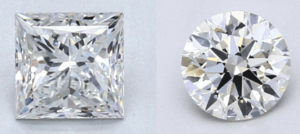
It’s easy to identify why princess cuts appear larger when you take note of their shape.
Combined with a lower price-per-carat than round cuts, maximize the size of your diamond by choosing a princess versus round cut diamond.
On the other hand, a poorly cut princess cut may look smaller. Light won’t reflect off it properly, which can decrease its perceived size to the naked eye.
My tip for choosing the carat weight of your princess cut is similar to my recommendation on clarity. It’s often impossible to tell the difference between two diamonds that are within 0.1 carats of each other.
So for example, you can avoid the premiums charged for one-carat diamonds by choosing one that weighs 0.9 carats, and they’ll look essentially identical.
Versatile Settings
There are a variety of settings available for princess diamonds, making it a versatile cut.
For example, you might prefer to keep the attention on the main diamond with a solitaire setting. It can be placed against yellow or rose gold or a platinum setting.
Here’s a princess cut diamond in a 14K rose gold setting.
There are other designs that feature small diamonds. A halo setting includes accents placed in a circle around the main stone.
This example of a princess cut engagement ring features an 18K white gold halo setting.
The halo adds 0.2 carats to the jewelry, and it’ll sparkle from every angle.
If you want the princess cut to stand alone on top of the ring, add diamonds to the band in a bead or channel setting. Accents complement the princess cut without drawing attention away from it.
To illustrate, this princess cut channel setting is made with 14K white gold.
Both the center and channel-set diamonds are princess cuts.
Some online vendors allow you to view how different cuts look on their settings. Explore a variety of settings with princess cuts to learn which is the right style for you.
Alternative to Traditional Round Cuts
Round cuts are by far the most popular choice for engagement rings. For some, this is an appealing trait because they want a traditional style.
But others want an alternative to a classic cut, and princess cuts fit the bill.
It’s estimated that 21 percent of diamonds are princess cuts. This is behind round cuts at 57 percent and ahead or marquise at five percent.
So you’re choosing a design that differs from most engagement rings but is still popular enough that it’s a recognizable shape.
The reason it’s the most popular fancy shape is because of the pros mentioned above:
- lower cost per carat
- strong light performance
- the ability to hide inclusions
- large visible appearance
- variety of settings
Combined, they make an exceptional case for princess cuts.
Cons of Princess Cuts
Corners Lack Durability
Princess cuts lack the durability of other cuts because of their sharp corners.
Their four corners are the most vulnerable to chips because it’s a thinner part of the diamond that can easily knock on furniture or other household items.
Other cuts, like emerald diamonds, have beveled edges that reduce their pointed ends. Compare the corners of the princess and emerald cuts below.
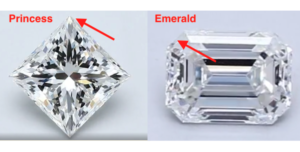
If a princess cut is dropped, the middle will likely stay intact, but the corners need protection.
Additionally, it may fall out of the setting.
The sharp corners are also more likely to snag on clothing items or catch on everyday items.
I recommend placing princess cuts in a setting that protects those corners.
Whether it’s V-prongs that wrap around both sides of each corner or a bezel setting that encloses all sides, it will minimize the chances of a chip.
For example, this ring features a bezel setting around a princess cut.
The four corners are covered by the ring of metal, which means if it’s dropped, the corners are safe. It maintains the square shape but guards the most vulnerable areas.
A protective setting should be balanced with brilliance. Too much metal covering the diamond means light won’t hit its surface, and it could appear dull.
So all that being said, prongs are still the most popular style for princess cuts. If you remove the ring during physical activity, quality prongs should suffice.
GIA Doesn’t Grade Cut Quality
The GIA is the preeminent organization for assessing the quality of diamonds.
One area included on GIA grading reports for round cut diamonds is cut. The quality of a diamond’s cut is the most important factor in its brilliance. A diamond with a poor cut can appear dull.
The GIA doesn’t provide cut grades for princess cut diamonds or any other fancy shape. There isn’t a consistent way to grade it for fancy shapes. Instead, the GIA provides measurements on traits that can determine the overall cut quality such as:
- Symmetry
- Polish
- Depth
- Proportions
- Girdle thickness
By examining each one individually, you can put together a more clear picture of a diamond’s cut quality. For example, you can gain confidence in its cut quality if it has the following traits:
- Excellent symmetry and polish
- Depth percentage of 65-75 percent
- Table percentage below 75 percent
- Girdle thickness: medium
Also view the diamond in person or through a high-quality image because you cannot know the precise quality of the cut from a GIA certificate.
I’ll walk through this process for this 1.02-carat princess cut.
The GIA report notes it has excellent symmetry and polish. The table percentage is 71 percent, and the depth percentage is 71.9%.
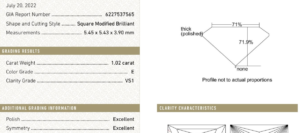
The only outlier is its thick girdle, even though it’s not too far outside the ideal range.
Shows Color More Than Round Cuts
A diamond’s color is graded on the extent of yellow or brown tints. Colorless diamonds with no yellow or brown earn the highest grades and are the most valuable.
Some cuts hide color better than others. Princess cuts and other fancy shapes show more color than round cuts. Similar to clarity, many buyers are most concerned with how the color appears to the naked eye.
For example, here’s a princess cut with a J color grade.
The yellow is apparent in the high-resolution image, and it’s likely visible to the naked eye.
In most cases, if you’re looking for a princess cut diamond that appears colorless, you should choose one graded I or above. You might have to move up the color scale to H or G if it’s heavier than one carat.

Its large table doesn’t always disguise color.
If the setting is platinum or white gold, I recommend at least an H color grade, like this lab-created princess cut engagement ring.
By choosing a princess cut in the “near colorless” category, you can often find one that looks identical to a colorless diamond. You’ll avoid the premium charged for ones designated colorless.
Should You Choose a Princess Cut?
It’s important to know the pros and cons of princess cut diamonds as you consider the right selection for you.
Consider a princess cut if:
- You want a square-shaped diamond that still has strong fire and brilliance
- The setting will protect its vulnerable corners
- You’re looking for a lower cost-per-carat compared to round cuts
- You want the diamond to look larger than many other cuts, even if it’s the same carat weight
- You can determine the quality of its cut by examining the measurements and grades on the GIA report
- You’re interested in an alternative to a round cut that’s still a common style for an engagement ring
Explore diamonds at online and in-person jewelry retailers.
By pairing it with the right setting, you’ll find the perfect ring for you with a princess cut on top.

Jacob Clarke
Jacob Clarke is the founder of TeachJewelry.com.
He earned an Applied Jewelry Professional Diploma from the Gemological Institute of America (GIA) and now brings you essential information about diamonds, settings, and more.
Jacob has consulted with leading jewelry brands, and his work has been cited in Clean Origin, Diamond Nexus and industry publications.
He's also a member of the International Gem Society.
He enjoys discussing jewelry with readers, so contact him with any questions at jacob.clarke@teachjewelry.com.


